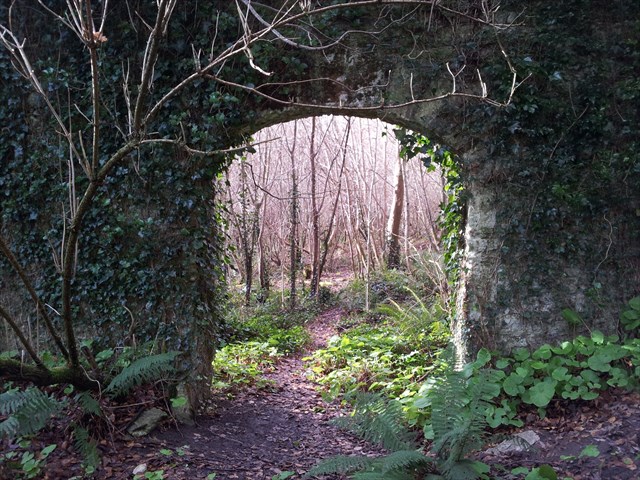The terrain is a mix of compacted soil and rock outcropping. Be
aware if there has been recent rain then the path leading in to the
trail can be muddy, I'd recommend you bring wellington boots just
in case, once you get beyond the initial path then the ground is
firm. Tree cover can make the GPS signal erratic
Rostellan Castle: Little now remains of Rostellan Castle, once seat
of the Marquess of Thomand and home of the Engledow family. Of the
castle itself, nothing remains; it was demolished by the army in
the 1920’s. Dotted around the environs, through the woods and
leading into them are some reminders of this once magnificent
stately home.
Note the castellated bridge as you drive to the car
park, incorporating a rare example of complex 18th century
milestone. Or the ruined remains of Sarah Siddons tower at the
western point of the wood on the edge of the seashore which was
built by Lord Inchiquin for the famous Drury lane actress. As you
search for the cache you will spot the Ice house – cold and
dark, this is a deep cave where winter ice was stored to keep food
cold in the days before refrigeration. It’s fenced off
– don’t venture in there, it’s very dangerous.
The secret garden – acres of kitchen gardens with complex
potting and heating sheds for maintaining the vegetable and fruit
and exotic flower supplies expected in a stately home. Now all
overgrown with trees – this is a Coillte wood.

Rostellan Castle was well known for it’s luxurious gardens –
accounts of expansive lawns leading down to an elevated terrace
overlooking the sea on which deer grazed.
THE SCENERY AND ANTIQUITIES OF IRELAND Illustrated by
W. H. Bartlett, circa 1841 Chapter IV....continued
…the course we took was under the shores of Rostellan,
the seat of the Marquess of Thomond.
The castle is delightfully situated on a wooded promontory, commanding
an exceedingly fine view of the grand and animated harbour with its
beautiful shores. The demesne is rich in luxuriant beauty, and the
judicious manner in which the grounds are laid out speaks highly
for the elegant taste of the noble owner. The present mansion is a
modern erection, built on the site of an old castle of the
Fitzgeralds, Seneschals of Imokilly. An ancient sword, said to have
been once wielded by Brian Boroihme, the great ancestor of the
O'Briens, and the monarch who defeated the Danes at the memorable
battle of Clontarf, is preserved in a small armoury of the castle,
and shown to strangers as a genuine relic.
A legend surrounds the building of Rostellan Castle… It’s said that in the
building of it the family were cursed for stealing gravestones to
use in its construction. A woman whose only son was buried cursed
the family saying their line would die out, that no sons would be
born and that while they lived there the crows would not nest in
Rostellan. Ultimately this was realised as the family failed to
thrive and eventually none were left. Now the crows are prolific in the woods.
Rostellan Wood Location:
Rostellan Wood is 12 km from Midleton, 32 km from Cork and 6 km from
Whitegate.
Woodland walks, picnic site and car park. Access to
'Mrs. Siddons Tower' was closed off due to poor structural
condition. Rostellan lake is a bird sanctuary which attracts large
numbers of bird watchers year-round. The trail of 2km runs through
mature stands of Norway spruce, Scots pine and broadleaves such as
Spanish Chestnut, Ash, Oak, Beech, Maple and Cherry. Other Flora:
Alder, hazel, birch and elder. Fauna: The fox, squirrel, stoat and
rabbit make their home side-by-side with the badger, duck, swan and
heron. History: The site was part of Rostellan Castle Estate. The
castle itself was demolished in the 1920s.
Geology: Brown earth.
Some limestone rock outcrop.
More information here:
Coillte Outdoors
Passage West & Monkstown
Buildings of Ireland
Buildings of Ireland II

[Clues are progressively more obvious]
Gur vpr ubhfr vf arne gur fjvat, frr svefg yvax
Sbyybj gur jnyyrq tneqra gb vgf raq
Ebhaq onpx bs uvtu jnyy